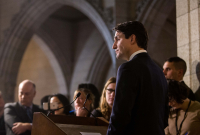Support strong Canadian climate journalism for 2025
In the theatre of politics, federal-provincial-territorial negotiations over health care tend to be all about the money: variations of more, more, more.
This was on full display last week, as Prime Minister Justin Trudeau offered a 10-year federal funding deal that no province or territory would realistically walk away from.
The more pressing question — the question that will determine whether billions of dollars will solve Canada’s public health-care pressures over the next decade — is quite basic: What will the provincial and territorial governments do with the money?
Just because federal transfers to the provinces for health care increase, doesn’t mean those dollars will be spent on health care. The provinces could move those funds out of health care and into other areas — or to tax cuts.
And they have.
Since the Canada Health Transfer was established in 2004, successive federal governments have increased funding by 195 per cent, but provincial and territorial health expenditures have grown more slowly — by 157 per cent, according to data from the Canadian Institute for Health Information.
This means that federal funding from the health transfer is accounting for an increasing share of health expenditures. So why is the health-care system still bursting at the seams?
Simply put, the provinces haven’t been doing their share of the heavy lifting — even though health care is their responsibility.
Take Ontario. According to the Financial Accountability Office (FAO), Ontario is not meeting commitments on a number of essential public services, including health care. Under the current plan, funding for health care in Ontario over the next three years will be $5 billion less than what is needed just to keep up with current government commitments. These commitments fall far short of what is needed to expand and improve services to address the pressures COVID-19 has exposed in the system.
The multiple crises the Ontario health care system has faced in recent months — from emergency department closures to delays in surgery and an outrageous backlog of patients who can’t access a family doctor — remain problems without a coherent plan to fix them.
That the Ontario government is underfunding the system while opening the door to public money subsidizing for-profit services, such as cataract surgery, speaks volumes.
Ontario is but one of a number of provinces led by premiers who don’t appear to be that interested in fixing the public health-care crisis; they’re more ideologically prone to look to the private market instead.
The issue at hand goes beyond provinces paying their share; it is also about value for money. As health-care expert Pat Armstrong points out, the push to propose more for-profit care is no answer to the crisis.
From a purely economic perspective, the requirement to provide returns to investors from for-profit care delivery means that costs will be higher than in the non-profit system.
These higher costs are paid either directly by increased government expenditures or indirectly through reduced expenditures on direct care, which will cut the quality of care that patients receive. They can also be paid directly by Canadians if more private billing is allowed for the wealthy to jump the queue.
Neither option will result in more functional emergency rooms, more family doctors, or shorter wait times for needed surgeries in the public health system. In fact, an expansion of private care can bleed the public system dry.
The good news is the provinces can afford another option, and that is to step up and adequately fund a public, not-for-profit health-care system.
On top of the 10-year federal funding offer, according to research by the Canadian Centre for Policy Alternatives’ senior economist David Macdonald, every province has either seen surpluses since the pandemic started or are projecting surpluses within their planning horizon. All but one province are projecting that they will have a larger fiscal balance at their disposal than before the pandemic started.
So the challenge isn’t only about money — it’s about ensuring there are stronger conditions attached to all new federal money, particularly that it actually be spent on health care, and that includes the new funds going to the Canada Health Transfer and for any bilateral agreements. We also need enhanced federal enforcement of the Canada Health Act.
We’ve seen this play before. Federal governments have increased funding without leveraging their power to ensure the money is actually spent on health care, and recent history tells us that is not a solution.
The prime minister needs to hold the premiers to a higher standard.
Sheila Block is a senior economist at the Canadian Centre for Policy Alternatives’ Ontario office.






Comments